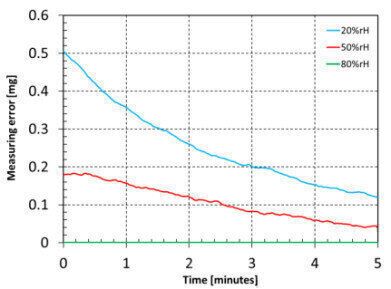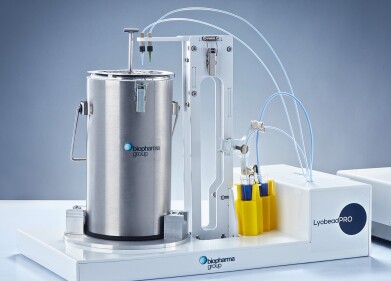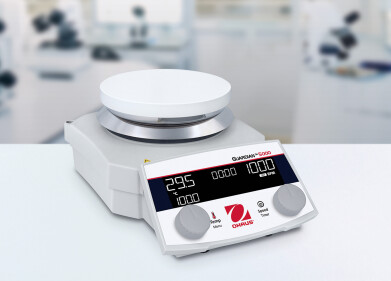-
 measuring error in mg as a function of time at 3 different relative air humidity ranges; from 80% to 20% for a glass flask
measuring error in mg as a function of time at 3 different relative air humidity ranges; from 80% to 20% for a glass flask
Laboratory Products
Integrated electrostatic detection in analytical weighing
Jan 29 2014
Abstract
Various examples of routine laboratory work show that electrostatic charges exert forces on the material to be weighed and the weighing pan, thus causing significant falsification of measurement results. Recent advances in weighing technologies allow the user to reduce these shortcomings. An integrated sensor for measuring the electrostatic forces during normal operation in an analytical balanced is presented and shown that errors over four orders of magnitude ranging from a few μg to several mg can easily be detected.
Introduction
An electronic analytical balance measures not directly a mass but the force of its weight. The uncertainty of this force depends on the technical specification of the instrument but also of many environmental effects like temperature variations, air drafts, evaporation or water adsorption of the object being weighed. In addition, the presence of electrostatic forces plays an important role in the accuracy of weighing data. Following a brief introduction to the physics of static electricity, this article describes how electrostatic charges arise and dissipate, how modern analytical balances detect their presence, and how large the measurement errors can be.
Static electricity
Friction is the most common way to generate electrostatic charges on a weighing vessel. Typical laboratory actions that cause items to become charged are for instance, the dry rubbing of a glass beaker with a cloth or touching a measuring flask with disposable gloves. Even unpacking a laboratory vessel from a plastic bag or filling it with loose material is sufficient to generate a measurable electrostatic charge.
These charges can be expressed by Coulomb’s Law [1], states that electrical charges exert a mutual force FE expressed as:...
View the full white Paper HERE>>
Digital Edition
International Labmate 49.6 - Sept 2024
September 2024
Chromatography Articles - HPLC gradient validation using non-invasive flowmeters Mass Spectrometry & Spectroscopy Articles - From R&D to QC, making NMR accessible for everyone: Putting NMR...
View all digital editions
Events
Oct 06 2024 Liverpool, UK
Oct 08 2024 Gothenburg, Sweden
Oct 09 2024 Birmingham, UK
Oct 09 2024 NEC, Birmingham, UK
Oct 15 2024 Milan, Italy

















